The Sosso was an interesting design produced experimentally by FNA Bescia in Italy in very small numbers during World War II. It was a short-recoil operated design chambered for 9x19mm, and featured a particularly unusual magazine design. Instead of using a convention spring and follow, the magazine contained what is best described as a belt-feed. A loop of chain in the magazine held 21 cartridges, and rotated one position each time the pistol was fired. This doesn’t seem to have had any particular benefit over a typical magazine (it certainly cost more to make), but it an interesting idea:
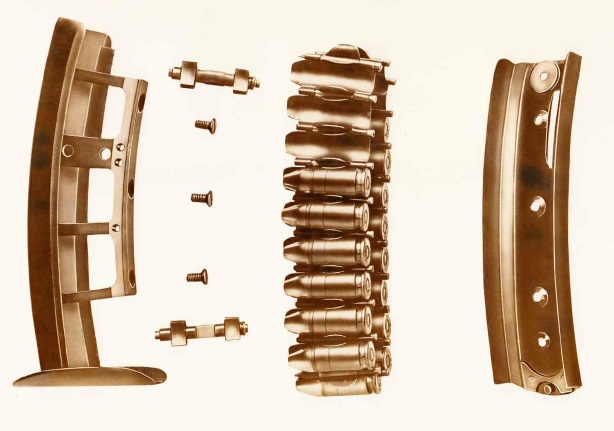
An example of a Sosso form the collection of Geoffrey Sturgess was sold by James Julia at auction, which gave us the opportunity to see some outstanding photos. This particular example (serial number 8A) included a holster-stock; a concept which was on its way out of popularity by the time these were being made. In addition, Julia also published an Italian-language copy of a Sosso manual, which I have not yet have the chance to translate:
Manuals
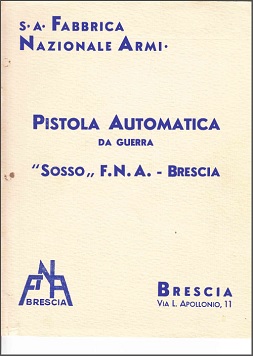
Photos


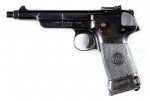

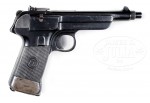



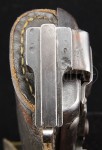





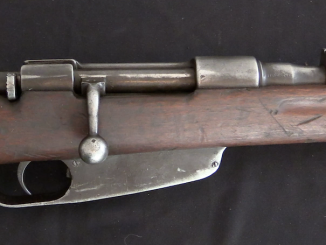

Only things I can think of for the mag is it could have been *intended* to increase reliability, were there any successful double stack pistols besides the High Power at the time? Also the 21 round capacity is pretty high for a pistol, especially for that era, so maybe that plays into it.
“were there any successful double stack pistols besides the High Power at the time”
American Savage Model 1907, Russian Voyevodin pistol (russian: Пистолет Воеводина, article in Russian wikipedia: https://ru.wikipedia.org/wiki/Пистолет_системы_Воеводина_(1939) ) with 18-round magazine, around 1500 were produced
Mauser C-96? Ten rounds in a double column magazine. ( Just for starters, but it’s the only one that comes to mind out of dozens in museums world wide.)
Agree w/Nick about reliability of the magazine, especially for high capacity.
Fantastic! Thanks for posting these excellent photos, Ian. The manual is also most welcome. I suppose that such ‘unusual’ (to say the least) mag arrangement may have added a lot of bulk to the grip. But hell, 21 rounds was a lot for pistol from that era, as Nich has pointed out. It must also have been a very expensive handgun to make. I’d love to see a video featuring it!
I had seen the Sosso back in the 1980s, in Italy, one in the Collection of Dr. Marciano’, editor of DIANA Armi, a Florence-based Italian Monthly Guns and Hunting Magazine, the other at the Beretta Museum, Gardone.
Reading the Manual, it is produced on “letterhead” Paper, and Hand-typed/then Mimeographed…the Type font is typical of Olivetti Typewriters of the time (Italian Alphabet)
Given that there are at least (Now) Three Known to exist, and the serialin the USA, 8A (I don’t know the ## of the Italian Located ones) and that THE SERIAL includes a Letter Suffix ( typical of RE Issue arms)then it would seem that a substantial quantity were made for at least Trials in the Field….How many others have survived???
BTW, I can translate the Manual for You and readers, in correct ( Italian to English)Ordnance Speak, if you wish…Please Contact at my Email.
Doc AV
( Balisticus Pedemontanus ex Galliam Cis-padanensis.)
yes a translation would be nice
It would do a few things (some of these have been pointed out by others):
By not having a spring at the bottom of the mag (taking up space when it was compressed) it would increase the number of rounds that a mag could hold.
It would remove “spring set” as an issue, esp. if it was issued to someone who might carry it for months and months before firing it.
It might be easier to load, the last few rounds would not be harder to insert
It might have an edge in reliability, as each cartridge would be presented with the same physical forces as all the others. No last-round jams. However, the mechanisim in the pistol to index the rounds would be a potential failure point.
It might be less prone to one not seating the magazine all the way during reloads, as one would not be pushing against a spring.
On the flip side, it probably would not work well dirty and would be harder to clean. And it is obviously more expensive. Did the gun in question lock open on an empty magazine?
Jacob and guys,
One frequent cause of mag-related malfs is follower tilt. Not possible here. (Of course, no doubt this complex feed mechanism has its own failure modes, that only experience would bring to the surface).
Very interesting and expensive design. As Jacop Morgan stated, springless magazine gives
more cartridge to store and easiness in loading, but if the position of chain is changed, it may give a undischarging trigger release like a revolver. According to the manual, barrel lock seems a verticaly elevating locking block with central single lug located under the breech section of barrel, camming block is also removable and connected with a retainer lever to stop the barrel at recoiled back situation during the
backward travel of slide. Giulia Sosso had three US Patents relating conveyor loader, magazine and sear constructions with serial numbers; 2031432, 2086339, 2251174 published from 1936 to 1941.
Best PISTOL capable to play Russian Roulette.
I find article but in Russian describing this pistol
http://topwar.ru/50730-pistolety-i-cepnye-magaziny-dzh-sosso-italiya.html
but it contains drawing from patent from July 6, 1937 number 2,086,339.
Hi Ian,
This document is actually an in depth technical description of the pistol including detail photos of components and specifications. The way it is presented looks and reads more like a trials submission SOQ (Statement Of Qualification) or a Patent submission. At any rate this is a super cool addition to the pistol.
im guessing this is hand made, hardly anything on it is symmetrical.
“So what’d you think of the gun?”
“Eh, it was sosso.”
Great stuff! I’ve been fascinated by this design since I read about it in Zhuk. Cheers Ian!
Here’s what Ezell in Handguns of the World has to say;
He also shows photos of the pistol and holster, both separated and assembled with the stock bar extended, credited to Henk L. Visser (NL). The “Visser” pistol is also dated 1942, has the same proof marks as “8A”, but has no number.
My thoughts;
1. The chain-feed mechanism would seem to be a fairly useless complication, but the curved magazine plus the chain feed would tend to ensure extremely reliable feeding of the tapered 9x19mm rounds. In essence, each round has its own “feed lips”.
This plus the stock and the unusually high magazine capacity (even by modern standards) leads me to suspect that the pistol was originally intended to be selective-fire; i.e., a machine pistol. In that context, its size, stock, and feed system make perfect sense, considering that it would probably have a ROF somewhere close to 1,100 R/M.
I’m wondering if among the Sosso pistols that may still be floating around somewhere, there might not be at least one with a safety with three positions instead of two; Safe, Single, and Auto.
2. The knurled button on the right side of the slide next to the rear sight strikes me as odd. Is it a slide lock release? If it is, it’s in a peculiar place.
3. I notice that the guns are marked “1942”, rather than the typical Roman “XX” I’d expect for “Year 20 of the Fascist Era” common on Berettas, etc. After the Italian capitulation in 1943, arms made for the Co-Belligerent Forces were sensibly marked with the Christian calendar year once again. Was FNA/Brescia subtly registering their dislike of Il Duce?
That’s all I’ve got. More questions than answers, but that’s half the fun of this, isn’t it?
😉
cheers
eon
One thing that occurs to me is that this may present an advantage over typical spring-based feeding designs in terms of scalability – this design could be increased in capacity up until the recoil energy is no longer sufficient to move the mass of the chain of ammunition, though I have no idea how much that could be.
Double the original capacity, maybe?
At any rate, it wouldn’t suffer from the same restrictions as conventional magazines, and changes to magazine geometry may not be needed. No curved mags, for instance.
(not a gunsmith)
Similar idea was revived in the 1990s in a Russian Anics air pistol, of all places, which also has this caterpillar magazine, but for pellets. There was also an Italian pistol in .25 ACP (I can’t remember the name right now) with a TRIPLE row magazine… Human ingenuity knows no bounds, they say 🙂
Aye that’s it, the Co2 gun.
Looks like an addition to your ‘clips and magazines’ lecture.
That holster-stock is interesting in that the alignment of it is reversed from what you typically see on a C96, Luger, Hi-Power, etc. And it mounts higher on the grip.
It may have been intended to allow a more “head up” posture for the shooter, rather than the “rifleman’s cheek-weld” position required for the C/96, etc.
The length of the pistol’s butt (to accommodate the high-capacity magazine), plus the height of the slide and rear sight, might have made this necessary to maintain the correct sight-line.
Also, there might have been a purely psychological factor. The first time most people fire a stocked self-loading pistol, they tend to be startled by the slide seemingly coming right at their eye. This induces flinch. Being able to hold the head more erect and thus further back from the rear of the slide might reduce this effect. (Just a SWAG.)
cheers
eon
That magazine idea has sort of been resurrected in Co2 pellet guns fairly recently.
I think a version would be handy for using Hornaday lock n load sabots, sort of spigotted sabots which you put pyrodex pellets around – caseless ammo in essence.
That stock looks like it has two positions, an early adjustable stock. That’s an interesting addition that you don’t see on many stocks of the time.
I believe that is one position with the metal rails extended to make the stock long enough to use, and one with them retracted for when you are using it as a holster and don’t want the rails sticking out.
It was also used in the 37mm M4 auto cannon used in the P39 Airacobra, and later on PT Boats.
Here is a great photo of the magazine: http://commons.wikimedia.org/wiki/File:37mm_T9_cannon.jpg
I meant the feed system.
there are two of these in the Beretta collection at their villa. I got to play with them about 20 years ago, definitely designed as a machine pistol, also made extensive use of aluminum.
Me thinks this magazine in a boberg would make feasible a high cap compact pistol in .22 lr (24 round mag?)